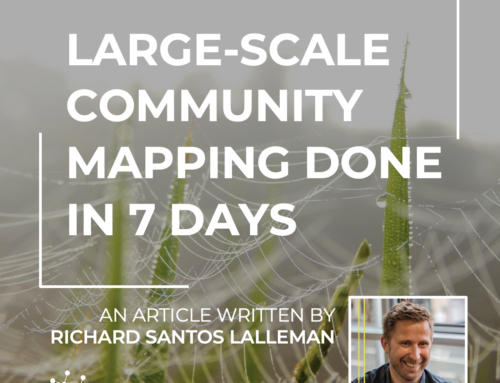DRIVE COLLABORATION
Hierarchy Persists as a Collaboration Barrier Amidst Agile Movements and DEI/DEIB/D&I Focus
September 27th, 2023 | Drive collaboration

In a time defined by the pursuit of equitable and integrated workplaces, a disconcerting trend has emerged.
An analysis of organizational network data spanning from 2016 to 2023 reveals that despite all the resources and efforts invested in fostering agile movements and Diversity, Equity, Inclusion, and Belonging (DEIB) initiatives, the promise of a more inclusive and balanced work environment remains elusive, particularly in the context of equal involvement of employees and managers in collaborative work inside companies.
The Collaboration Landscape Has Remained Steadfastly Unequal
Over the course of seven years, a striking picture has been painted of the persistent hierarchy within organizations. A disheartening truth is unveiled as it becomes evident that managerial dominance continues to cast a shadow on the vision of a harmonious and collaborative workforce. Amidst the intense focus on promoting agility and addressing DEIB matters, the collaboration landscape has remained steadfastly unequal.
The data underscore an unswerving reality:
This discrepancy took a startling leap while people were forced into remote work. In this period, managers were even 4 times more involved in collaboration than their fellow employees.
Are Flat Organizations An Utopia?
This evidence-based revelation on the power of collaborative network prompts profound questions. Despite the proliferation of discussions on fostering flattened organizational structures, the findings starkly illuminate that hierarchies have not only endured but have thrived in this transformative period.
It casts a glaring light on the potential limitations of even the most well-intentioned endeavors to drive agile methodologies and DEIB principles.
We need to reflect on the broader implications for workplace dynamics. The ongoing challenge to dismantle the deeply embedded hierarchical structures highlights the necessity for a more network-oriented approach. Such an approach would align organizational values with tangible outcomes, placing emphasis on empowering employees, fostering innovation, and enhancing overall well-being. That way we can make better steps to become ‘flat organization’.
However, it is worth noting that:
This is exemplified in cases such as a 600+ person company with minimal hierarchy, demonstrating that a balance between structure and flexibility was key to their scale-for-growth strategy.
The Way Forward For Every Agile Movement or DEIB Initiative Inside Companies
There is path forward: informed decisions grounded in evidence from a more network-oriented approach. The key lies in deciphering the intricate networks that weave through the organizational fabric. These networks not only expose the pain points that have perpetuated imbalances but also guide our attention toward critical focal areas. It is through this lens that the solution emerges: by understanding who engages, how they engage, and where interventions can lead to transformative change.
The power of data-driven network insights empowers us to dismantle entrenched barriers and craft strategies that foster inclusivity and collaboration. So, the journey begins with harnessing the potential of networks to pave the way for a workplace that is not only collaborative but truly reflective of the diverse voices that compose it.
DRIVE COLLABORATION
Hierarchy Persists as a Collaboration Barrier Amidst Agile Movements and DEI/DEIB/D&I Focus
September 27th, 2023 | Drive collaboration

In a time defined by the pursuit of equitable and integrated workplaces, a disconcerting trend has emerged.
An analysis of organizational network data spanning from 2016 to 2023 reveals that despite all the resources and efforts invested in fostering agile movements and Diversity, Equity, Inclusion, and Belonging (DEIB) initiatives, the promise of a more inclusive and balanced work environment remains elusive, particularly in the context of equal involvement of employees and managers in collaborative work inside companies.
The Collaboration Landscape Has Remained Steadfastly Unequal
Over the course of seven years, a striking picture has been painted of the persistent hierarchy within organizations. A disheartening truth is unveiled as it becomes evident that managerial dominance continues to cast a shadow on the vision of a harmonious and collaborative workforce. Amidst the intense focus on promoting agility and addressing DEIB matters, the collaboration landscape has remained steadfastly unequal.
The data underscore an unswerving reality:
This discrepancy took a startling leap while people were forced into remote work. In this period, managers were even 4 times more involved in collaboration than their fellow employees.
Are Flat Organizations An Utopia?
This evidence-based revelation on the power of collaborative network prompts profound questions. Despite the proliferation of discussions on fostering flattened organizational structures, the findings starkly illuminate that hierarchies have not only endured but have thrived in this transformative period.
It casts a glaring light on the potential limitations of even the most well-intentioned endeavors to drive agile methodologies and DEIB principles.
We need to reflect on the broader implications for workplace dynamics. The ongoing challenge to dismantle the deeply embedded hierarchical structures highlights the necessity for a more network-oriented approach. Such an approach would align organizational values with tangible outcomes, placing emphasis on empowering employees, fostering innovation, and enhancing overall well-being. That way we can make better steps to become ‘flat organization’.
However, it is worth noting that:
This is exemplified in cases such as a 600+ person company with minimal hierarchy, demonstrating that a balance between structure and flexibility was key to their scale-for-growth strategy.
The Way Forward For Every Agile Movement or DEIB Initiative Inside Companies
There is path forward: informed decisions grounded in evidence from a more network-oriented approach. The key lies in deciphering the intricate networks that weave through the organizational fabric. These networks not only expose the pain points that have perpetuated imbalances but also guide our attention toward critical focal areas. It is through this lens that the solution emerges: by understanding who engages, how they engage, and where interventions can lead to transformative change.
The power of data-driven network insights empowers us to dismantle entrenched barriers and craft strategies that foster inclusivity and collaboration. So, the journey begins with harnessing the potential of networks to pave the way for a workplace that is not only collaborative but truly reflective of the diverse voices that compose it.
Related articles
Share article
Share article







